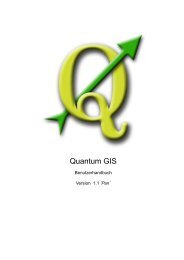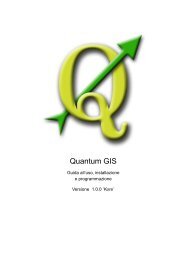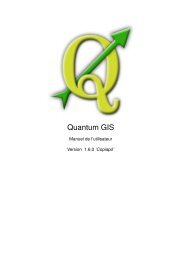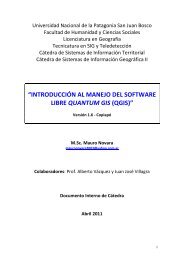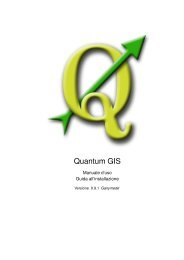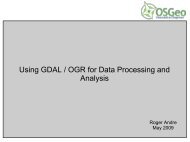QGIS User Guide - OSGeo Download Server
QGIS User Guide - OSGeo Download Server
QGIS User Guide - OSGeo Download Server
You also want an ePaper? Increase the reach of your titles
YUMPU automatically turns print PDFs into web optimized ePapers that Google loves.
5.2.5. Migliorare le prestazioni<br />
5.2 Layer PostGIS<br />
Richiamare dati geografici da un database PostgreSQL può richiedere molto tempo, specialmente<br />
se il server dei dati si trova in rete. È possibile migliorare le prestazioni di resa a video di layer<br />
PostgreSQL assicurandosi di creare un indice spaziale su ogni layer nel database. PostGIS supporta<br />
la creazione di un indice GiST (indice dell’albero generalizzato di ricerca, Generalized Search Tree)<br />
per velocizzare le ricerche spaziali di dati.<br />
La sintassi per la creazione di un indice GiST è: 3<br />
CREATE INDEX [indexname] ON [tablename]<br />
USING GIST ( [geometryfield] GIST_GEOMETRY_OPS );<br />
Si noti che per tabelle molto grandi, la creazione dell’indice può richiedere parecchio tempo.<br />
Non appena l’indice è stato creato, bisognerebbe effettuare una VACUUM ANALYZE. Si veda la<br />
documentazione di PostGIS [4] per ulteriori informazioni.<br />
Ciò che segue è un esempio di come creare un indice GiST:<br />
gsherman@madison:~/current$ psql gis_data<br />
Welcome to psql 8.3.0, the PostgreSQL interactive terminal.<br />
Type: \copyright for distribution terms<br />
\h for help with SQL commands<br />
\? for help with psql commands<br />
\g or terminate with semicolon to execute query<br />
\q to quit<br />
gis_data=# CREATE INDEX sidx_alaska_lakes ON alaska_lakes<br />
gis_data-# USING GIST (the_geom GIST_GEOMETRY_OPS);<br />
CREATE INDEX<br />
gis_data=# VACUUM ANALYZE alaska_lakes;<br />
VACUUM<br />
gis_data=# \q<br />
gsherman@madison:~/current$<br />
5.2.6. Layer vettoriali che attraversano 180 ◦ di longitudine<br />
Many GIS packages don’t wrap vector maps, with a geographic reference system (lat/lon), crossing<br />
the 180 ◦ longitude line. As result, if we open such map in <strong>QGIS</strong>, we will see two far, distinct locations,<br />
3 le informazioni sull’indice GiST sono tratte dalla documentazione PostGIS disponibile su<br />
http://postgis.refractions.net<br />
<strong>QGIS</strong> 1.4.0 <strong>User</strong> <strong>Guide</strong> 45




